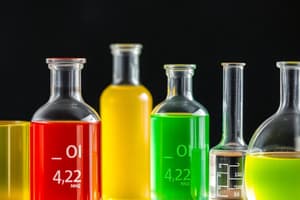Podcast
Questions and Answers
What is the primary characteristic of a Lewis acid?
What is the primary characteristic of a Lewis acid?
- Proton donor
- Forms hydronium ions
- Electron pair acceptor (correct)
- Releases hydroxide ions
Which of the following is a correct example of an Arrhenius acid?
Which of the following is a correct example of an Arrhenius acid?
- K2SO4
- HCl (correct)
- NaOH
- Ca(OH)2
How can you form the conjugate base of a Brønsted-Lowry acid?
How can you form the conjugate base of a Brønsted-Lowry acid?
- Replace the acid with a Lewis acid
- Remove a hydrogen atom and decrease the charge (correct)
- Add a hydrogen atom and increase the charge
- Add a hydroxide ion
Which statement is true regarding Arrhenius bases?
Which statement is true regarding Arrhenius bases?
What do Brønsted-Lowry acids and Lewis acids have in common?
What do Brønsted-Lowry acids and Lewis acids have in common?
Arrhenius acids release H+ ions in solution.
Arrhenius acids release H+ ions in solution.
Brønsted-Lowry bases donate protons to other substances.
Brønsted-Lowry bases donate protons to other substances.
Lewis acids are electron pair donors.
Lewis acids are electron pair donors.
Hydronium ions result from the combination of H+ ions with hydroxide ions.
Hydronium ions result from the combination of H+ ions with hydroxide ions.
When an acid donates a proton, it forms its conjugate base.
When an acid donates a proton, it forms its conjugate base.
The Lewis definition of acids and bases does not involve protons at all.
The Lewis definition of acids and bases does not involve protons at all.
The conjugate acid of H2O is the hydroxide ion OH-.
The conjugate acid of H2O is the hydroxide ion OH-.
BH3 acts as a Lewis acid because it has vacant orbitals.
BH3 acts as a Lewis acid because it has vacant orbitals.
Flashcards
Arrhenius Acid
Arrhenius Acid
A substance that releases hydrogen ions (H+) or hydronium ions (H3O+) in solution.
Arrhenius Base
Arrhenius Base
A substance that releases hydroxide ions (OH-) in solution.
Brønsted-Lowry Acid
Brønsted-Lowry Acid
A proton (H+) donor.
Brønsted-Lowry Base
Brønsted-Lowry Base
Signup and view all the flashcards
Lewis Acid
Lewis Acid
Signup and view all the flashcards
What is a conjugate acid?
What is a conjugate acid?
Signup and view all the flashcards
What is a conjugate base?
What is a conjugate base?
Signup and view all the flashcards
What is a Brønsted-Lowry acid?
What is a Brønsted-Lowry acid?
Signup and view all the flashcards
What is a Brønsted-Lowry base?
What is a Brønsted-Lowry base?
Signup and view all the flashcards
What is a Lewis acid?
What is a Lewis acid?
Signup and view all the flashcards
What is a Lewis base?
What is a Lewis base?
Signup and view all the flashcards
What is an Arrhenius acid?
What is an Arrhenius acid?
Signup and view all the flashcards
What is an Arrhenius base?
What is an Arrhenius base?
Signup and view all the flashcards
Study Notes
Arrhenius Definition of Acids and Bases
- Arrhenius acids release hydrogen ions (H+) or hydronium ions (H3O+) in solution.
- H+ ions in water are associated with water molecules to form hydronium ions (H3O+).
- Examples of Arrhenius acids: HF (hydrofluoric acid), HCl (hydrochloric acid), H2SO4 (sulfuric acid), HNO3 (nitric acid).
- Arrhenius bases release hydroxide ions (OH-) in solution.
- Arrhenius acid donate H+ ions to water creating hydronium ions (H3O+) and their conjugate base.
- Arrhenius bases dissociate in water to produce metal ions and hydroxide ions (OH-).
- Examples of Arrhenius bases: NaOH (sodium hydroxide), KOH (potassium hydroxide), Ca(OH)2 (calcium hydroxide).
Brønsted-Lowry Definition of Acids and Bases
- Brønsted-Lowry acids are proton (H+) donors.
- Brønsted-Lowry bases are proton (H+) acceptors.
- When an acid donates a proton, it forms its conjugate base.
- When a base accepts a proton, it forms its conjugate acid.
- To find the conjugate acid: Add one hydrogen and increase the charge by one.
- To find the conjugate base: Remove one hydrogen and decrease the charge by one.
- Examples of Brønsted-Lowry acid-base reactions:
- HF (hydrofluoric acid) + H2O (water) → H3O+ (hydronium ion) + F- (fluoride ion)
- HF is the Brønsted-Lowry acid (proton donor)
- H2O is the Brønsted-Lowry base (proton acceptor)
- H3O+ is the conjugate acid of H2O
- F- is the conjugate base of HF
- CO32- (carbonate ion) + H2O (water) → HCO3- (bicarbonate ion) + OH- (hydroxide ion)
- H2O is the Brønsted-Lowry acid (proton donor)
- CO32- is the Brønsted-Lowry base (proton acceptor)
- HCO3- is the conjugate acid of CO32-
- OH- is the conjugate base of H2O
- HF (hydrofluoric acid) + H2O (water) → H3O+ (hydronium ion) + F- (fluoride ion)
Lewis Definition of Acids and Bases
- Lewis acids are electron pair acceptors.
- Lewis bases are electron pair donors.
- Lewis acids often have an incomplete octet and can accept electron pairs.
- Lewis bases have lone pairs of electrons they can donate.
- Lewis base is also known as a nucleophile (electron-rich).
- Lewis acid is also known as an electrophile (electron-poor).
- Example of a Lewis acid-base reaction:
- BH3 (borane) + NH3 (ammonia) → BH3-NH3 (ammonia-borane adduct)
- BH3 is the Lewis acid (electron pair acceptor)
- NH3 is the Lewis base (electron pair donor)
- The nitrogen atom in NH3 donates a lone pair of electrons to the empty orbital on boron in BH3.
- BH3 (borane) + NH3 (ammonia) → BH3-NH3 (ammonia-borane adduct)
Key Concepts
- Conjugate acid: the species formed when a base accepts a proton.
- Conjugate base: the species formed when an acid donates a proton.
- Nucleophile: an electron-rich species attracted to electron-poor centers, typically a Lewis base.
- Electrophile: an electron-poor species attracted to electron-rich centers, typically a Lewis acid.
Studying That Suits You
Use AI to generate personalized quizzes and flashcards to suit your learning preferences.




